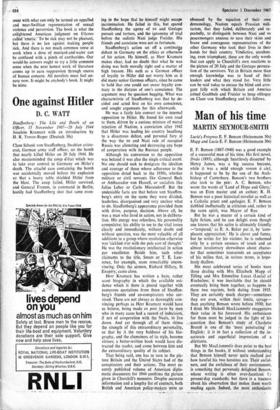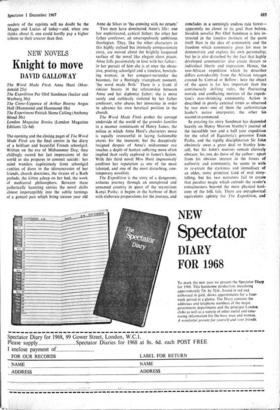Man of his time
MARTIN SEYMOUR-SMITH
E. F. Benson (1867-1940) was a good example of a successful man of his time. His first novel, Dodo (1893), although `heartlessly dissected' by Henry James, was a big success because, while it was a mild enough roman a clef, it happened to be by the son of the Arch- bishop of Canterbury. Benson's two brothers also took to the pen: A. C. Benson, who wrote the words of 'Land of Hope and Glory,' was an Eton master and an author; R. H. Benson was a poor historical novelist as well as a Catholic priest and apologist. E. F. Benson dabbled ineffectually in criticism and, rather in the same spirit, was Mayor of Rye.
But he was a master of a certain kind of light fiction, and he can delight even- though one knows that his satire is ultimately friendly =tempered,' as E. A. Baker put it, by `com- placent appreciation.' He is clever and funny, but be writes for his victims; he is redeemed only by a certain sureness of touch and an almost involuntary shrewdness about charac- ter that sometimes transcends an acceptance of his milieu that, in serious terms, is hope- lessly shallow.
His most celebrated series of books were those dealing with Mrs Elizabeth Mapp of Tilling and Mrs Emmeline Lucas (Lucia) of Risehohne; it was inevitable that he should eventually bring them together, as happens in these two reprints, both dating from 1935. They are certainly much sharper—sometimes they are even, within their limits, savage— than anything Benson wrote before 1930; but I think Mr Micheal MacLiammOir exaggerates their value in his foreword. His enthusiasm for them must be judged in the light of his rassertion that Benson's study of Charlotte Brontë is one of the `most penetrating' in English : it is in fact a collection of the in- accurate and superficial impressions of a dilettante.
But Mr MacLiammdir does point to the best things in the books, if without understanding that Benson himself never quite realised just how hateful his two heroines are. Their awful- ness, and the awfulness of their environment, is something that perversely delighted Benson, whose writing is often over-facetious t y present-day standards; but there is a trueness about his observation that makes them worth reading again. Indeed, the most enthusiastic readers of the reprints will no doubt be the Mapps and Lucias of today—and, when one thinks about it, one could hardly pay a higher tribute to their creator than that.



































 Previous page
Previous page